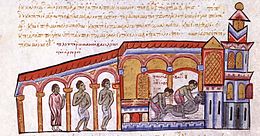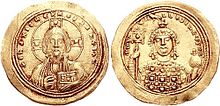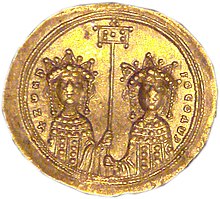Spoke 11: The Biblewheel and The 11th Century
Zoë Porphyrogenita Purple-Born
The 11th and 12th books mentioned that Jezebel and Athaliah had become rulers, Jezebel ruling even on her husband Ahab; and Athaliah ruling Judah once her son Ahaziah was dead.
Porphyrogenita means born into the purple. Both Zoë and Constantine VII were born in the 10th century as they were born in the palace.
Zoë was conscious of her beauty and had a variety of creams and treatments as was Jezebel who was surrounded by eunuchs.
Zoe's lover Michael IV had become a servant under her husband Romanos III Argyros. With Zoe's consent Michael IV murdered Romanos III in his bath:
Zoë Porphyrogenita Purple-Born
The 11th and 12th books mentioned that Jezebel and Athaliah had become rulers, Jezebel ruling even on her husband Ahab; and Athaliah ruling Judah once her son Ahaziah was dead.
Porphyrogenita means born into the purple. Both Zoë and Constantine VII were born in the 10th century as they were born in the palace.
Zoë was conscious of her beauty and had a variety of creams and treatments as was Jezebel who was surrounded by eunuchs.
Zoe's lover Michael IV had become a servant under her husband Romanos III Argyros. With Zoe's consent Michael IV murdered Romanos III in his bath:
Zoë Porphyrogenita
| Zoë Porphyrogenita | |
|---|---|
| Empress and Autocrat of the Romans | |

Mosaic of Zoë at the Hagia Sophia
| |
| Empress of the Byzantine Empire | |
| Reign | 10 April 1042 – June 1050 |
| Predecessor | Michael V Kalaphates |
| Successor | Constantine IX and Theodora |
| Born | c. 978 Constantinople |
| Died | June 1050 (aged 72) Constantinople |
| Burial | Constantinople[1] |
| Spouse | Romanos III (1028–1034) Michael IV (1034–1041) Constantine IX (1042–1050) |
| Dynasty | Macedonian |
| Father | Constantine VIII |
| Mother | Helena |
Zoë Porphyrogenita (Greek: Ζωή "life" Medieval Greek: [zo'i]; c. 978 – June 1050) reigned as Byzantine Empress alongside her sister Theodora from 10 April 1042 to June 1050. She was also enthroned as empress consort to a series of co-rulers between 1028 and 1042.
Zoë was born to a nominal co-emperor, Constantine VIII, but lived a life of relative obscurity until the age of 47. Her uncle Basil II then died, leaving the Byzantine throne entirely to her father. As he had no sons, Constantine hoped to continue the dynasty by marrying off one of his daughters.
Zoë, aged 50, was married to Romanos III Argyros, who became emperor three days later on her father's death. The marriage was troubled and after five years Romanos was found dead in his bath. His death has been variously attributed to Zoë or her young lover. They were married on the same day as the murder, and he was crowned emperor as Michael IV on the following day.[2]
Seven years later, Zoë was persuaded to adopt her dying husband's nephew, also named Michael. Once Michael V became emperor, he promptly exiled Zoë. This sparked a popular revolt which dethroned him and installed Zoë and her sister Theodora as joint empresses. After a two-month joint reign Zoë married a former lover, who was installed as Constantine IX Monomachos, transferring power to him. Eight years later, Zoë died aged 72.
...
From Romanos III to Michael V: 1028–1042
Spending years in the same restrictive quarters with her sister, Zoë had come to loathe Theodora.[8] She also never forgave Theodora for being their father’s first choice to marry Romanos.[16] Zoë convinced Romanos to appoint one of his own men as the chief of Theodora’s household, with orders to spy on her.[17] Shortly afterwards, Theodora was accused of plotting to usurp the throne, first with Presian of Bulgaria in 1030, followed by Constantine Diogenes, the Archon of Sirmium, in 1031.[18] Zoë accused her of being part of the conspiracy, and Theodora was forcibly confined in the monastery of Petrion. Zoë later visited her sister and forced her to take religious vows.[19]
Zoë was obsessed with continuing the Macedonian dynasty.[9] Almost immediately upon marrying Romanos the fifty-year-old Zoë tried desperately to become pregnant. She used magic charms, amulets, and potions, all without effect.[20] This failure to conceive helped alienate the couple, and soon Romanos refused to share the marriage bed with her.[21] Romanos limited his wife's spending and paid her little attention.[2]
Zoë, furious and frustrated, engaged in a number of affairs. Romanos tolerated these and took a mistress himself.[22] In 1033 Zoë became enamoured of a low-born servant called Michael. She flaunted her lover openly and spoke about making him emperor. Hearing the rumours, Romanos was concerned and confronted Michael, but he denied the accusations.[2]
In early 1034 Romanos became ill and it was widely believed that Zoë and Michael were conspiring to have him poisoned.[23] On 11 April Romanos was found dying in his bath.[22] According to court official and later chronicler Michael Psellus some of his retinue had "held his head for a long time beneath the water, attempting at the same time to strangle him".[23] John Scylitzes writes as a simple fact that Romanos was drowned on Michael's orders.[23] Matthew of Edessa's account has Zoë poisoning Romanos.[23]
Zoë and Michael were married on the same day that Romanos III died.[9] The next day they summoned the Patriarch Alexios I to officiate at the coronation of the new emperor.[24] Although he initially refused to co-operate, the payment of 50 pounds of gold helped change his mind.[9] He proceeded to crown Michael as the new emperor of the Romans, to reign as Michael IV until his death in 1041.[25][26]
Although Zoë believed Michael would prove to be a more devoted husband than Romanos, she was mistaken. Michael IV was concerned about Zoë turning on him the way she had turned on Romanos,[27] so he excluded Zoë from politics by placing all power in the hands of his brother, the eunuch John the Orphanotrophos.[28] Zoë was confined again to the palace gynaeceum, and kept under strict surveillance,[27] while Michael’s visits grew more and more infrequent.[10] The disgruntled empress conspired against John, but in vain.[9]
By 1041 it was obvious that Michael IV was dying.[29] John the Eunuch, eager to ensure that power remained in his hands, forced Zoë to adopt Michael IV's nephew, the son of his sister, also called Michael.[22] On 10 December 1041, Michael IV died, refusing to the last to see his wife who begged that she be allowed to visit him one more time,[30] and Michael V was crowned emperor.[31]
Although he had pledged to respect Zoë, Michael V promptly banished her to a monastery on Principus, an island in the Sea of Marmara, on charges of attempted regicide. She was forcibly tonsured and sworn into a religious order.[32] This treatment of the legitimate heir to the Macedonian Dynasty caused a popular uprising in Constantinople. Michael V, desperate to keep his throne, brought Zoë back from Principus and displayed her to the people,[33] but his insistence that he continue to rule alongside her was in vain. On 19 April 1042 the mob dethroned Michael V in support of not only Zoë, but also Theodora.[34]
A delegation headed by Patrician Constantine Cabasilas[35] went to the monastery at Petrion to convince Theodora to become co-empress alongside her sister. Accustomed to a life of religious contemplation Theodora rejected them and sought sanctuary in the convent chapel. In the event she was carried forcibly back to the capital.[34] At an assembly in Hagia Sophia the people escorted a furious Theodora and proclaimed her empress along with Zoë.[36] After crowning the two empresses the mob stormed the palace, forcing Michael V to escape to a monastery.[37]
...
Ruling with Theodora and Constantine IX: 1042–1050
Zoë immediately assumed power and tried to force Theodora back to her monastery, but the Senate and the people demanded that the sisters should jointly reign.[38] As her first act Theodora was called upon to deal with Michael V. Zoë, weak and easily manipulated, wanted to pardon and free Michael, but Theodora was clear and adamant. She initially guaranteed Michael’s safety, but then ordered him to be blinded and to spend the rest of his life as a monk.[39]
Officially Zoë was the senior empress, and her throne was situated slightly in front of Theodora's on all public occasions. In practice Theodora was the driving force behind the joint administration. The sisters proceeded to administer the empire, focusing on curbing the sale of public offices and on the administration of justice.[40] Although contemporary historian Michael Psellus claimed the joint reign was a complete failure, John Scylitzes stated that they were very conscientious in rectifying the abuses of the previous reigns.[41]
Theodora and Zoë appeared together at meetings of the Senate and gave public audiences, but it was soon apparent that their joint reign was under strain.[42] Zoë was still jealous of Theodora and had no desire to administer the empire; but she would not allow Theodora to conduct public business alone. The court began to split, with factions forming behind each empress.[42] After two months of increasing acrimony, Zoë decided to search for a new husband – thereby denying Theodora the opportunity to increase her influence.[43] By the rules of the Orthodox Church her next marriage, her third, was the last she was permitted.[9]
Her preference was for Constantine Dalassenos, who had been her father's first choice as her husband back in 1028. He was brought for an audience before the Empress, but during their conversation his independent and forceful manner displeased Zoe, and he was dismissed from her presence.[42] Her next choice was the married Constantine Atroklines, a court official with whom it was rumoured that she had had an affair during the reign of Romanos III.[22] He died under mysterious circumstances a few days before the wedding was to take place, possibly poisoned by his own soon to be ex-wife.[42]
Zoë then remembered the handsome and urbane[42] Constantine Monomachos, another former lover.[22] The pair were married on 11 June 1042, without the participation of Patriarch Alexis, who refused to officiate over a third marriage (for both spouses).[44] On the following day Constantine was formally proclaimed emperor together with Zoë and Theodora.[44]
Zoë got more than she bargained for when Constantine decided to bring with him to his new station his long-standing mistress Maria Skleraina.[45] Not content with bringing her to court, he insisted that he be allowed to publicly share his life with her, and that she obtain some official recognition.[46] The 64-year-old Zoë did not object to sharing her bed and her throne with Skleraina. Skleraina was given the title of sebaste, ranking behind Zoë and Theodora, and was addressed as mistress or empress, like them. At official events Skleraina took position immediately behind the sisters.[9]
In the eyes of the public however, Constantine IX’s preferential treatment of Skleraina was a scandal, and eventually rumours began to spread that Skleraina was planning to murder Zoë, and possibly Theodora.[47] This led to a popular uprising by the citizens of Constantinople in 1044, which came dangerously close to actually harming Constantine who was participating in a religious procession along the streets of Constantinople.[48] The mob was only quieted by the appearance on a balcony of Zoë and Theodora, who reassured the people that they were not in any danger of assassination.[48] During Constantine’s reign, Zoë handed over all imperial power and responsibility to him.
It is said that Zoë was stunningly beautiful, and Michael Psellos in his Chronographia commented that "every part of her was firm and in good condition".[49] Zoë recognised her own beauty and its use as a tool of statecraft. Attempting to maximise and prolong its effect she had a variety of creams and treatments prepared in the gynaeceum, and was said to have carried out experiments attempting to improve their efficacy. She operated a cosmetics laboratory in her rooms in the palace, where perfumes and unguents were constantly being prepared. Psellus reports that her face looked youthful into her sixties.[9][50] Zoë died on 11 June 1050 aged 72.[51]
![Biblewheel: A wise king scattereth the wicked, and bringeth the wheel over them. [Pro 20:26 KJV]](https://blogger.googleusercontent.com/img/b/R29vZ2xl/AVvXsEgiFT6-YCyrSoMjVlsXjQIWJVHaMXsChgqmAIk9mLeNmsgqWXD94k5TOPejvnORdnQ39OL3U4FleKWbC1r46q2t5nYnipb_qDZFNHQR_YXesnm6ucYt2g1DjbBhXnZmML3IHhunsYSeRBU/s1600-r/biblewheel_traced_edited.png)





No comments:
Post a Comment